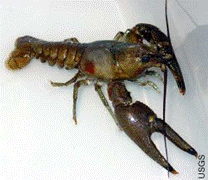|
"Your gateway to
understanding |
Rusty crayfish
click for full size
• Discovered in Oneida Lake in 2005
• Larger than native crayfish
• Consume more food than native crayfish due to their higher metabolic rate
Rusty crayfish are native to streams in Ohio, Kentucky, and eastern Indiana. They were likely introduced to Oneida Lake by anglers who used them as fish bait. A second vector is also possible. Rusty crayfish can be privately purchased from biological supply companies and could have been later released into local waters from home or school aquaria. Although rusty crayfish were first noted in Oneida Lake in 2005, they were likely present for several years before.
Rusty crayfish are brown with large, black-tipped claws and a rust-colored spot on each side of their bodies. Adults can grow to 8 inches long, but most are in the 3 to 5 inch range. They inhabit lakes, ponds, and streams, and can be found in areas with slow or fast moving water. They prefer areas that offer cover such as rocks, logs, or other debris.
Rusty crayfish are aggressive and may out compete native crayfish for food and habitat. Due to their higher metabolic rate, they consume more food than native crayfish. Their ability to displace native crayfish combined with their larger size may result in less food availability or shifts in diet for fish such as black bass. Rusty crayfish thrive on aquatic vegetation, and abundant food source in Oneida Lake.
To learn more about Rusty crayfish ...
Rusty Crayfish Factsheet (pdf - 145kb)

